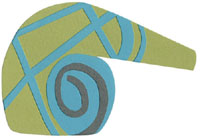
The lagom guide to celebrations

Never is the lagom philosophy more evident than with celebrations. Christmas, Easter and midsummer tend to be relaxed affairs, geared towards being together, keeping the costs down and sharing the load. Gifts are carefully selected to be just right for the occasion and wrapped in simple, understated paper. Decoration is an equally delicate balance – overdo it, and it will be considered vulgar, underdo it, and it won’t look festligt (party-like).
Every year our family celebrates Christmas twice – once with the Swedish side of the family and once in London. So not lagom, I know, but since neither my husband nor I was ready to skip our annual family Christmas, we agreed this was the best solution! Each festive occasion is wonderful in its own way. In Sweden, it’s celebrated on December 24 and centred around a fantastic julbord (Christmas table) – a buffet bursting with Swedish delicacies like pickled herrings, eggs, Jansson’s temptation (potato with anchovies), meatballs, and many, many other foods.
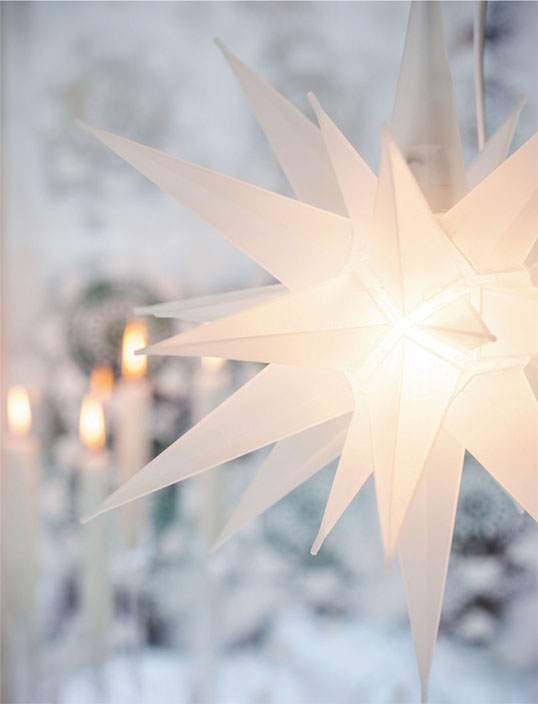
plainpicture/Johner/Anna Skoog
Although we all have our traditions – and perhaps I’m not quite ready to swap a turkey for pickled herring – I admire the way my family-in-law organizes the event. Each person is responsible for bringing something to the table, quite literally.
I’ve noticed that helping out and contributing food and drink to a big event is common at all Swedish celebrations – whether it’s the aforementioned julbord or a midsummer table. Dividing up tasks not only takes the pressure off the host but also means everyone has a sense of responsibility for making the day great. In essence, by sharing out responsibility for dishes, drinks, children’s food, music, a quiz and even a treasure hunt, everyone has a lagom amount to do, no one is out of pocket, and everyone enjoys a more relaxed affair.
Understated decorations
When it comes to Christmas decorations in Sweden, there’s a distinct serenity and cosiness, and also a strong sense of nostalgia. On the whole, coloured flashing lights and Father Christmas climbing up the side of the house are strictly out of bounds. I don’t even want to imagine what would happen if you placed a 10-foot inflatable snowman in your garden. No. When it comes to decorating lagom style, think flickering candles, delicate fairy lights with a soft, off-white glow, vintage decorations and tablecloths that have been passed down from generation to generation, as well as handmade and natural touches from outside your door.
In the days running up to Christmas, there’s usually a tree frenzy, with everyone in search of the perfect pine – not too tall, too short, too stout, too asymmetrical, too bushy or too sparse. But what if I said: the more imperfect the tree, the better?
Since many Swedes chop down their own trees, it can be a case of using whatever’s grown in the garden over the year. But even if the tree is selected from a farm or a local store, there’s still an emphasis on imperfection. In fact, some even shun the conical-shaped pine for a Lebanese cedar tree (also very popular in Denmark). It’s fairly spartan, often crooked and far from perfect, but it’s incredibly charming and has many benefits. The spacing between the branches means you can see each decoration more clearly, and it also allows space for real candles.
By picking up an imperfect tree you’ll add a bucket-load of rustic charm to your home at Christmas. But for an extra Swedish touch, search online for ‘Scandinavian Christmas tree’ inspiration – you’ll find the internet awash with images of trees in wicker baskets. It took me some time to learn how to recreate this look. The trick is to find a tree planted in a pot rather than chopped off at the stem. If you manage to get a tree with roots, even better – you can replant it in your garden for next Christmas!
Chopping down your Christmas tree
With so much forest on their doorstep, it’s not uncommon for Swedes to chop down a tree in their garden or visit a nearby Christmas-tree farm. Since moving to Sweden, I’ve preferred heading out to a tree farm with a saw over selecting one in the supermarket car park. Our annual tree-chopping ceremony is accompanied by a load of warm clothes (see here and here), a Thermos of glögg (a form of mulled wine) and pepparkakor (ginger thins – see here). Needless to say, it’s one of our favourite days of the whole year!
Sustainable Christmas-tree farms are becoming increasingly popular across Europe and beyond, so why not look for one in your area and make chopping down your tree a new tradition? Nothing beats the smell of fresh pine and the sense of achievement – plus, by choosing the right farm, you’ll know it’s from a sustainable source.

plainpicture/Cultura/jf
Think outside the sitting room!
It’s easy to think a Christmas tree should be confined to the corner of the sitting room. But since moving to Sweden, I’ve been inspired by the practice of placing mini trees in other parts of the house, too. Whether in the bedroom (oh so cosy to wake up to!), on the coffee table, in the window or even on the stairs, there’s no end to where you might place one. My children love having their own mini trees in their bedrooms, and they make handmade decorations for them (with varying results!). You can also place them either side of your front door for a warm welcome. Forget fancy decorations – leave them au naturel or add a simple string of white fairy lights to brighten up the darkest of corners.
Real Christmas-tree candles
Real candles were the only option before electrical fairy lights took over. And, lately, people have been taking a leaf from times gone by and reverting to the real deal. We had wax candles on our tree for the first time last Christmas, and, I have to say, it looked truly magical. Since they’re only lit for half an hour or so at a time, it becomes a bit of an occasion as the family gathers around to enjoy them. Also, since you can’t leave the tree unattended, you need to stand or sit and watch it for the best part of 30 minutes before blowing out the candles again – which is surprisingly mindful. And, most important of all, the soft glow of candlelight nestled between the pine needles is a truly beautiful sight. I wholeheartedly recommend it! Don’t forget to stay safe – be vigilant, always keep a bucket of sand by the tree, ensure candles are placed well away from the branches above and never leave the tree unattended when candles are lit.
Vintage decorations
In Sweden, it’s not uncommon to decorate the tree with flag garlands and little treasures made from wood, tin and glass that have been passed down from generation to generation. Why not have a rummage around your local flea markets in the run-up to the holiday season and give forgotten items a new lease of life? The more mismatched, the better!
Crafting
Swedes love to pysslar (get creative) before any big holiday. They generally set aside a day to make decorations and bake as a family. To julpysslar (create Christmas crafts) may involve making a gingerbread house (see here), a candle wreath (see here) or paper stars to hang on the tree. The beauty is that the creation doesn’t have to be perfect – in fact, the more rustic, the better. It’s simply about getting together and enjoying the moment.
Many Swedes like to forage for seasonal items like pine cones, holly sprigs, boxwood and acorn cups, which they’ll then use to create centrepieces, a wreath and little decorative touches for all over the home. Traditionally, Christmas decorations start to go up on the first day of Advent, although subtle, homemade seasonal wreaths on the door offer a warm welcome long before this. Natural homemade decorations are very much about keeping the look simple and letting the shape of the leaves and the scent of the freshly cut foliage speak for itself.

Alisa Anton/Unsplash
TWO SIMPLE CHRISTMAS DECORATIONS
INSPIRED BY NATURE

To create an immediate sense of holiday spirit, hang a homemade wreath on your door or in the window. It doesn’t have to be complicated – in fact, the simpler it is, the more charming and inviting it will feel!
The hanging-candle wreath
A single flickering candle in the window can brighten up even the darkest of days. This simple candle wreath is relatively easy to create and looks beautiful hanging in the window. Once finished, light the candle and watch it twinkle in the dark.
What you need
+ A bundle of eucalyptus foliage (you can also use boxwood, spruce or anything else that is in season and readily available)
+ Green garden wire
+ Wire cutters
+ Round metal frame (a coat hanger bent into shape will also do!) approximately 35cm (14in) diameter or larger, depending on the candle you would like to use
+ Leather or twine for hanging
+ Clip-on candle holder
+ Small candle
What to do
1. Take three sprigs of foliage and bind them together at the stem using the garden wire.
2. Use wire to fix the stems of the bundle to the metal frame.
3. Create a new foliage bundle and overlap the tips with the first bundle to hide the wire, then fasten them in place with more wire.
4. Continue until you’ve covered half of the circle.
5. Measure the height at which you would like to hang the wreath and then attach the appropriate length of leather string or twine to the centre of the top half of the metal frame – the uncovered half – using a small knot. Cut away the excess.
6. Add the clip-on candleholder to the centre of the bottom half of the wreath – the half that is covered in foliage – and fix the candle in the holder. Hang the wreath vertically in your window and watch it twinkle!
Ice tea-light holders
These ice tea-light holders are a lovely way to light up a path or add a twinkle to your doorstep. To make your own, pour water into a bowl or plant pot until it’s half full. Then add a handful of greenery to the water. Take a second bowl and place it inside the first bowl of water (being careful not to press it all the way down). If temperatures are below zero, leave them outside or, if not, place them in the freezer. Wait for the water to freeze (the length of time depends on the amount of water you’ve used and the conditions, but to err on the safe side leave overnight) before carefully removing both bowls. Add a tea light and enjoy seeing them brighten up the darkness.
‘One becomes kind from ginger thins.’ Swedish proverb

No Christmas in Sweden would be complete without pepparkakor. Dating back to the 14th century, pepparkakor are crunchy ginger thins with notes of cinnamon, ginger and cloves. Traditionally, they were thought to have medicinal properties, and according to Swedish folklore, your wish will come true if you hold a ginger thin in the palm of your hand, gently tap its centre and it breaks into three pieces. They are sometimes handmade but more often bought, and you can enjoy them plain or (my favourite) with cheese and a dollop of fig jam, washed down with a steaming mug of hot cocoa or glögg, a form of Swedish mulled wine.
Children are sometimes invited to carve out different-shaped pepparkakor, using cookie cutters, before decorating them with white icing or simply leaving them natural. And if you’re feeling creative, you can buy them with a hole in place and create the sweetest of sweet decorations to hang on the Christmas tree or in a cluster in the kitchen. Alternatively, you can decorate a name on the ginger thin to create edible gift tags – it’s a deliciously sweet addition to your gift wrapping.
Why not take your pepparkakor craft skills to the next level and make a gingerbread house? Whether it’s a miniature house to enjoy with a hot chocolate and marshmallows or an entire estate, the only limit is your imagination. And if all else fails, you can eat it before anyone sees it. What have you got to lose?
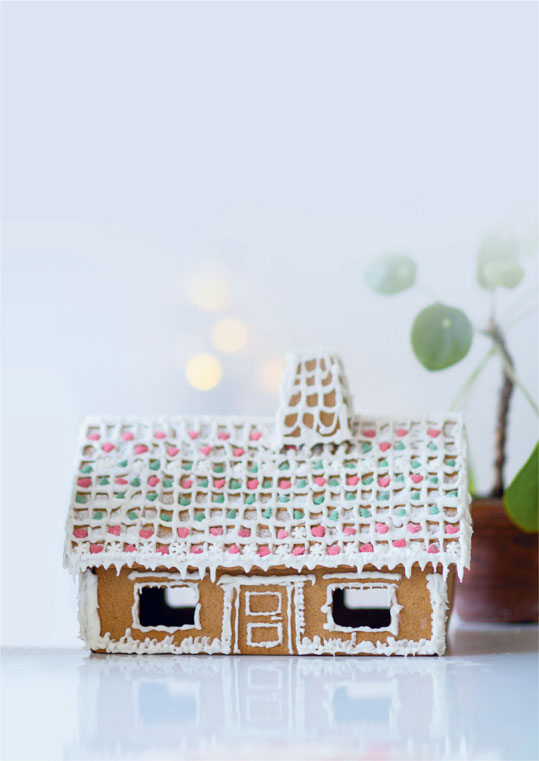
plainpicture/Johner/Pemilla Head
As with most holidays, the Swedish house before påsk (Easter) is a hive of activity. Easter decorations come out of the attic, feathers are tied to bushes outside the door, and little eggs hang from branches in the garden and in a prime spot inside. Often, the family will also set aside a day for påskpysslar (Easter crafting) to add a handmade touch before the children dress up as påskkärringar (little Easter witches) and go around the neighbourhood with a basket collecting sweets. Do the latter in your country and they might think you’ve lost your mind! But there are some Swedish traditions that are easy to recreate.
Egg dying
Who doesn’t love dying eggs at Easter time? Most of the time you don’t need to follow a tutorial – simply hard-boil your eggs and dip them into a food-colouring dye and arrange them in a bowl for an instant seasonal touch! Or, if you want to go that eggs-tra (sorry!) mile, replace the food colouring with dye made from non-toxic natural products. Experiment with the different foods and look online for recipes to create the colours you need.
My children enjoy this game every year on Easter day at their Swedish grandparents’ house (I have to say, it’s fun as an adult, too – my husband and I get quite competitive!). There are many versions of the game, but we tend to hard-boil a dozen eggs, climb to the top of a hill and roll the eggs down it. The person whose egg gets the furthest wins. (You can repeat until your egg completely falls apart or choose to eat it before it gets to that fateful stage.)
Äggpickning – egg scrambling
Also known as egg scrambling, äggpickning is a traditional Easter game played by two or more players. First, the participants hard-boil and paint or dye their eggs. Then the aim is to knock or ‘peck’ the top of the other’s unshelled egg until one of them cracks. If there are more than two people involved, the winners go through to the next round.
Easter table decorations
It’s incredible the lengths to which some Swedes will go to get that Easter vibe at home: I’ve even seen curtains decorated with chicks and eggs! On the whole, however, effortless yet fun touches are key, and they are relatively easy to achieve.
I first visited Sweden when I was nine years old, and one of my earliest memories is wearing a wildflower crown in my hair and dancing around a maypole. Unbeknownst to me, I was participating in one of the biggest events in the Swedish calendar: midsummer. Since the Swedes are a very practical nation, the summer solstice is celebrated on the Friday between 19 and 25 June. Traditionally, midsummer was connected to magic, and gathering wildflowers was seen as a way to secure nature’s magical powers to ensure good health for the rest of the year.
Today, villagers gather together to erect a large maypole decorated with wild flowers. Girls with floral crowns, boys and adults alike then dance around the maypole to tunes such as Små Grodorna (‘The Little Frogs’) to celebrate the warm weather (not always the case) and long days. After the revelry, everyone tucks into a feast of herring, potatoes, strawberries and other delicacies. It’s fast become one of my favourite events of the year, thanks to the simple, rustic nature of the day. There are no gifts and no frivolities – it’s just a time to get together with all generations and revel in the abundance of daylight.
A guide to celebrating midsummer
You don’t need a midsummer pole to celebrate the longest day of the year. Why not gather family and friends on the summer solstice, put flowers in your hair and enjoy supper al fresco to drink in the light and celebrate warmth and sunshine?
However, if you would like to go all out and celebrate the Swedish way, here are a few key ingredients you need to think about:
+ Invite friends and family over for the summer solstice.
+ Make your own midsummer pole (there are plenty of YouTube clips on how to do this!) and decorate with leaves entwined with wild flowers.
+ Create floral crowns together for the girls in the group (see here).
+ Play some music and dance around the pole (occasionally hopping like a frog!).
+ Enjoy an al fresco feast of herring, potatoes and strawberries washed down with beer and schnapps. (You may want to plan for an awning and blankets in case of bad weather – as is tradition at midsummer!)
+ Create song sheets of a series of fun, short ditties and encourage the group to sing intermittently during the course of the meal.
A FLORAL CROWN

What you need
+ Garden wire
+ Wire cutters
+ Tape measure
+ Green foliage
+ An assortment of freshly picked wild blooms with stems cut to 8cm (3in) lengths
What to do
1. Take a length of wire and form it into a circle, leaving the ends loose.
2. Measure the crown of your head to see how big the circular shape needs to be and use the wire cutters to remove excess wire.
3. Tie the ends of the circle together ensuring there are no sharp edges.
4. Wrap green foliage around the circle and secure into place using wire.
5. Add a bloom and secure into place with the garden wire.
6. Overlap the stem of a bloom with a new flower until you come full circle.
Swedish tradition dictates that if a single woman gathers seven different types of flowers and places them under her pillow on midsummer day, she’ll dream of the man she’s going to marry.

Jordan Sanchez/Unsplash
Invited to a celebration? Why not channel the Swedes and pride yourself on being the perfect guest? Simple steps like offering to contribute something to the event, turning up on time and bearing a thoughtful present will have your host positively beaming and set the tone for a wonderful time.
The lagom gift
My husband always puts the brakes on my dinner-party gifts and gets slightly panicked at the sight of more than one. Having experienced Swedish gift exchanges over the years, I now understand that it’s extremely important not to go over the top, which will inevitably embarrass the recipient and show up the other guests. It’s also important not to bring too little (or to go empty-handed). In other words, the present should be just right for the occasion. Quite often, guests will arrive armed with thoughtful, handmade gifts, which I’ve found are the most valued of all. It means that someone has put time, effort and thought into creating it just for you, and it’s nearly always unique!
Three homemade gifts your friends will love
+ A bouquet of seasonal herbs: pick a selection of herbs from your garden and bind them with plain brown string and place in a jam jar with water. Write a little note saying which herbs they are and that once the roots come through, they can plant them in their garden. Who doesn’t love the scent of thyme, rosemary and mint on a summer’s day?
+ Cake in a jar: treat your friend to something delicious! Layer the ingredients for a batch of brownies or another favourite bake in a jar and note the recipe on a gift tag so they can make it themselves on a rainy day.
+ Sow a seed in a simple terracotta pot and provide care instructions. Your friend can watch the seedling grow and, if it’s edible, enjoy it for lunch at harvest time.
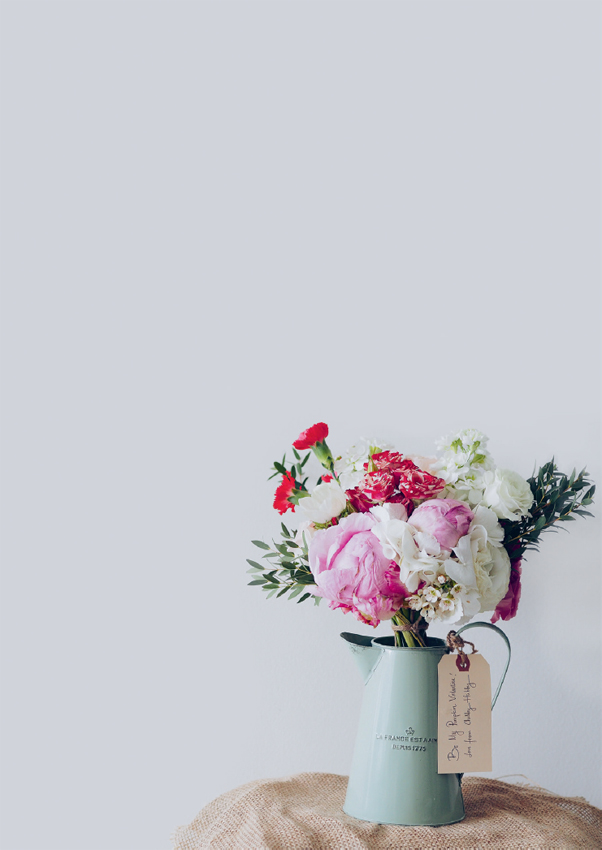
Leonardo Wong/unsplash
Invite friends over for a celebration, and they’ll arrive with beautifully wrapped gifts. What sets Swedish present wrapping apart is that they’ll forgo ostentatious ribbons and expensive wrapping paper in favour of understated natural brown or white paper (or even newspaper) tied with simple brown garden string or traditional black-and-white twine. But mundane it’s not! A delicate bloom from the garden adds a touch of colour and a divine scent on someone’s birthday. Or, at Christmas, cinnamon sticks or mini pine cones offer the perfect replacement for an expensive bow.
Design your own gift wrap
Take gift wrapping one step further and decorate the paper with white or gold stickers. Or have some fun with a traditional potato stamp to create your very own design!
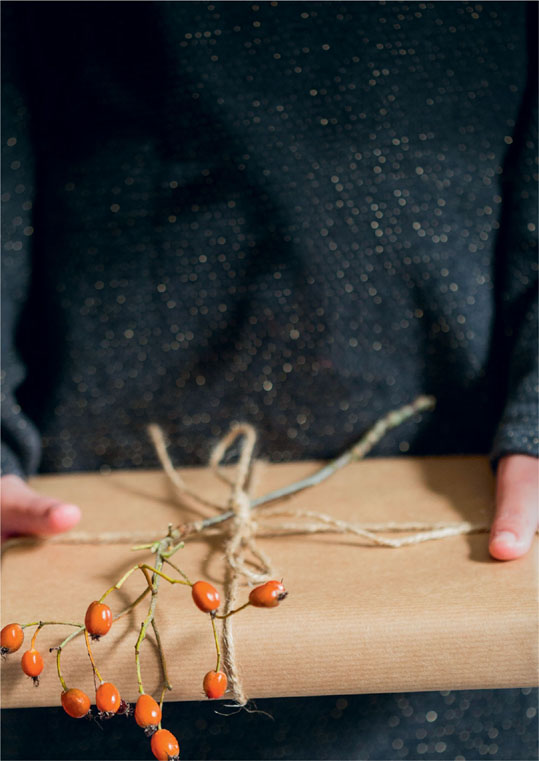
plainpicture/Folio Images/Lina Ostling
You’ll never see Swedes spend hours in a card shop. They simply don’t ‘do’ cards like we do in the UK. Swedish cards tend to be of the one-sided postcard variety or a simple parcel label. Being British, this is a style I find hard to adopt. Having said that, with my children attending birthday parties almost weekly and plenty of our own friends celebrating being another year older, I have saved an immense amount of time and money not using the card shop.
If you’re running late for a friend’s birthday and don’t have time to buy a card, you can always follow the Swedish approach and attach a simple postage label (white or neutral will do) to the present. Add a drawing or stickers, or use a stamp to personalize it, and take the time to write a thoughtful message.
Staying overnight?
In Sweden, it’s customary to offer to bring your own bedding when visiting a friend or relative, especially at their summer cottage where there might not be enough linen to go round (or a washing machine for after you’ve left). If you’re staying overnight, why not offer to bring your own linen? It won’t create any more effort on your side, but it eases the burden on the host, who doesn’t need to spend your arrival day making up beds and your departure day in a space akin to a Chinese laundry room. Less work all round!